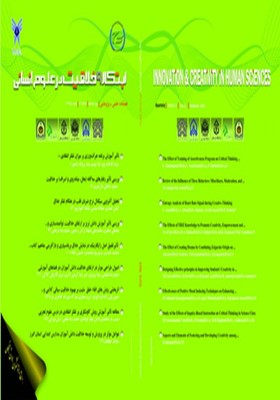An Effectiveness of positive Mood inducing Techniques on enhancing of creativity fluent Verbal and flexibility student of Islamic Azad university Najaf Abad
Subject Areas : Creativity and innovation from psychological, epistemological, educational and pedagogicalhossien valizadeh gharagoozulo 1 * , Karim AsgariMobarake 2 , Mehrdad Kalantari 3
1 - psychologist hospital Air Force
2 - استاد یار دانشگاه اصفهان
3 - دانشیار دانشگاه اصفهان
Keywords: Key Words: mood induction procedures", creativity fluent Verbal", creativity flexibility,
Abstract :
Abstract Background: Creativity is a human cognitive abilities. As a rule a cognitive style affected. There are bilateral relationship between mood and cognition. As' we think about emotional states involved in the formation of mood and emotional states influence on cognitive processes. The present study was aimed to investigate the effectiveness of mood induction methods to improve creativity fluent Verbal and flexibility in the students of Islamic Azad University of Najaf Abad. The design of this study was Quasi-experimental with a pretest- post test control group and Evaluation. The sample in this study was selected randomly from the students of Islamic Azad University Najaf Abad. They were then placedin to experimental and control groups. Mood induction procedures were taught for 8 sessions of 90 minutes each experimental group. Instrument included abedi Creativity Test inventory. The results of the analysis of covariance showed that mood induction methods was effective in inducing positive mood in the students, however it was effective on their creativity fluent Verbal and flexibility. Scores will increase their creativity ,results of this study it can be concluded, mood induction methods creates significant induction(0/05) was able to enhance students 'creativity fluent verbal And flexibility, significant relationship was between mood induction procedure and creativity fluent Verbal and flexibility Key Words: mood induction procedures, creativity fluent Verbal, creativity flexibility.
آرگایل، مایکل. (1386). روانشناسی شادی، ترجمه: مسعود گوهری، حمید نشاط دوست، حسن پالاهنگ، فاطمه بهرامی. اصفهان: جهاد دانشگاهی.
اسماعیلی، مریم. (1389). اثربخشی روش های مداخله رفتاری-شناختی، در بهزیستی روانشناختی فرزندان جانباز اختلال پس از سانحه در اصفهان. پایان نامه دکتری دانشگاه اصفهان.
سورگی، سمیه. (1375). بررسی مقایسه شخصیتی دانش آموزان خلاق و غیر خلاق مراکز استعدادهای درخشان تهران. پایان نامه کارشناسی ارشد، دانشگاه علامه طباطبایی تهران.
ساعتچی، محمود. (1390). آزمون های روانشناختی. تهران: ویرایش.
کلارک، دیوید میلر؛ فربون، کریستوفرج. (1380). رفتار درمانی شناختی، ترجمه: کاویانی. تهران: فارس.
خسروی، زهره؛ درویز، زهرا؛ رفعتی، مریم. (1377). نقش حالت های هیجانی بر شیوه ارزیابی دانش آموزان دختر در توانایی مشکل گشایی خود. فصلنامه اندیشه و رفتار، 4(1): 35-45.
ولی زاده، حسین. (1391). اثر بخشی روش های القاء خلق بر بهبود خلاقیت و علایم افسردگی دانشجویان دانشگاه آزاد اسلامی نجف آباد. پایان نامه کارشناسی ارشد. رشته روانشناسی بالینی. دانشگاه آزاد نجف آباد.
Baas, M; De Dreu, C. K.W; Nijstad, B. A. (2008). 'A Meta-Analysis of 25 Years of Mood–Creativity Research: Hedonic Tone, Activation, or Regulatory Focus?' journal Psychologicali Bulletn, Vol. 134, No: 6, 779–806.
Bower, G. H. (1992). How might emotions affect learning? Ins. A. Christianson (e d). Hand book of emotion and memory Hill date, NJ: Lawrence Erlbaum associates. Ins.
Ding, X. Tang, Y; Deng, Y; Tang, R; Posner, M. (2014). Mood and personality predict improvement in creativity due to meditation training. Journal homepage, Learning and Individual Differences, pp, 1-25. http://dx.doi.org/10.1016/j.lindif.2014.11.019
Ding, X; Tang, Y; Tang, R; Posner, M. (2014).Improving creativity performance by short-term meditation. Gournal Behavioral and Brain Functions, vol. 10, N: 9, pp, 2-8.
Forgas, G. P. Bower, G, M. (1989). Mood effection person perception, journal of personality and socail Psycholoy, 53, 53-60.
Lyubomirsky, S. king, L; Diener E. (2005) The Benefits of Frequent Positive Affect: Does Happiness Lead to Success? Gournal Psychological Bulletin, Vol. 131, No: 6, 803–855.
Leung, A .K; Liou, S; Qiu, L; Kwan, L. Y; Chiu, C.Y, Yong; J.(2014). The Role of Instrumental Emotion Regulation in the Emotions–Creativity Link: How Worries Render Individuals With High Neuroticism More Creative. Journal Article, Vol. 14, No: 5, 846-856. http://dx.doi.org/10.1037/a0036965
Rodica Baltes, F. & Miu, A, C. (2014). Emotions during Live Music Performance: Links with Individual Differences in Empathy, Visual Imagery, and Mood. Journal Psychomusicology, Vol. 24, No: 1, 58–65
Silivia, P. J; Kaufman, J, C & Pertz, J, E. (2008). Is creativity domain- specific? Latent class models of creative accomplish ments and creative self- descriptions. Psychology of aesthetics. Journal creativity and the arts, vol. 3, No: 3, 139-148.
Sternberg, R, J. (2005). Creativity or creativities? Journal of human coputer studies, 63,370-383.
Torrence, E. P. (2003). The millennium: A time for looking forward and looking back. Journal of secondary gifted education. Vol. 15, No: 1, 6-13.
_||_

